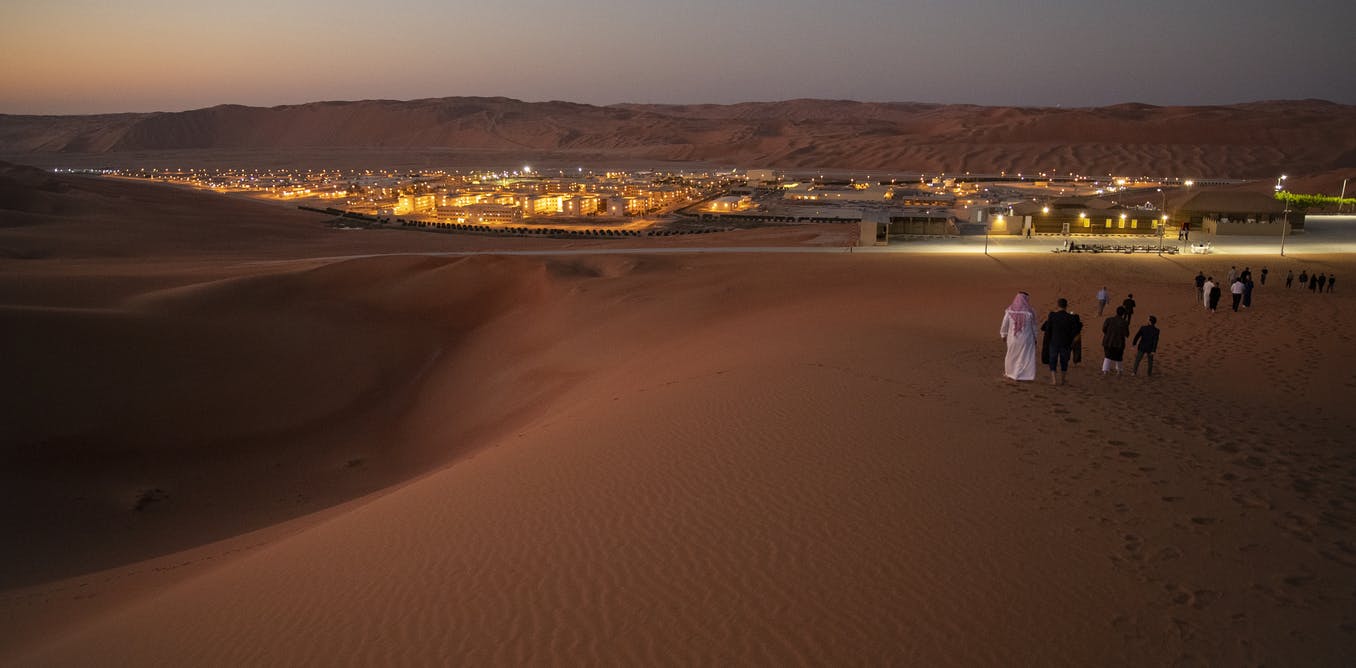Saudi Arabia is under increasing fiscal pressure as oil prices plunge to near four-year lows, jeopardizing government revenue and its ambitious Vision 2030 diversification agenda. Brent crude recently dipped below $65 a barrel, far short of the estimated $90+ required to balance Riyadh’s budget, according to the IMF.
The decline threatens tens of billions in lost revenue and a sharp reduction in dividends from state oil giant Saudi Aramco (TADAWUL:2222), with government and Public Investment Fund (PIF) incomes set to shrink by $32 billion and $6 billion respectively. In 2023, oil accounted for 62% of state revenue, and 2024’s twin deficits—fiscal and current account—are already widening.
Despite Vision 2030 being funded off-budget, massive infrastructure projects like NEOM and the 2034 World Cup demand capital. PIF, managing $925 billion in assets and holding Aramco shares, plans to boost annual investments from $40–50 billion to $70 billion by 2025. However, falling oil revenue has made debt financing essential. Saudi public debt surged 16% to over $324 billion in 2024, and analysts expect an additional $100 billion over three years.
PIF raised $11 billion in early 2025 following $24.8 billion in debt issuance last year. State-linked entities have also turned to global debt markets. Meanwhile, the finance ministry is recalibrating spending to avoid overheating the economy while keeping the private sector on track.
Despite short-term setbacks, Saudi Arabia retains investor confidence, supported by a low debt-to-GDP ratio. S&P recently upgraded its credit rating to ‘A+’, although warned that rising debt and volatile oil prices pose long-term risks. As global geopolitical shifts unfold, Riyadh remains committed to delivering its key Vision 2030 milestones, even as timelines and project scopes may be adjusted.



 Bank of Japan Poised for Historic Rate Hike as Inflation Pressures Persist
Bank of Japan Poised for Historic Rate Hike as Inflation Pressures Persist  Asian Stocks Slide as AI Valuation Fears and BOJ Uncertainty Weigh on Markets
Asian Stocks Slide as AI Valuation Fears and BOJ Uncertainty Weigh on Markets  U.S. Dollar Slips Near Two-Month Low as Markets Await Key Jobs Data and Central Bank Decisions
U.S. Dollar Slips Near Two-Month Low as Markets Await Key Jobs Data and Central Bank Decisions  Oil Prices Rebound as Trump Orders Blockade of Sanctioned Venezuelan Tankers
Oil Prices Rebound as Trump Orders Blockade of Sanctioned Venezuelan Tankers  Singapore Growth Outlook Brightens for 2025 as Economists Flag AI and Geopolitical Risks
Singapore Growth Outlook Brightens for 2025 as Economists Flag AI and Geopolitical Risks  RBA Unlikely to Cut Interest Rates in 2026 as Inflation Pressures Persist, Says Westpac
RBA Unlikely to Cut Interest Rates in 2026 as Inflation Pressures Persist, Says Westpac  New Zealand Budget Outlook Shows Prolonged Deficits Despite Economic Recovery Hopes
New Zealand Budget Outlook Shows Prolonged Deficits Despite Economic Recovery Hopes  Trump Orders Blockade of Sanctioned Oil Tankers, Raising Venezuela Tensions and Oil Prices
Trump Orders Blockade of Sanctioned Oil Tankers, Raising Venezuela Tensions and Oil Prices  Oil Prices Slip in Asia as 2026 Supply Glut Fears and Russia-Ukraine Talks Weigh on Markets
Oil Prices Slip in Asia as 2026 Supply Glut Fears and Russia-Ukraine Talks Weigh on Markets  U.S. Dollar Steadies Near October Lows as Rate Cut Expectations Keep Markets on Edge
U.S. Dollar Steadies Near October Lows as Rate Cut Expectations Keep Markets on Edge  Asian Stocks Slide as AI Spending Fears and Global Central Bank Decisions Weigh on Markets
Asian Stocks Slide as AI Spending Fears and Global Central Bank Decisions Weigh on Markets  BoE Set to Cut Rates as UK Inflation Slows, but Further Easing Likely Limited
BoE Set to Cut Rates as UK Inflation Slows, but Further Easing Likely Limited  Silver Prices Hit Record High as Safe-Haven Demand Surges Amid U.S. Economic Uncertainty
Silver Prices Hit Record High as Safe-Haven Demand Surges Amid U.S. Economic Uncertainty  Bank of Korea Downplays Liquidity’s Role in Weak Won and Housing Price Surge
Bank of Korea Downplays Liquidity’s Role in Weak Won and Housing Price Surge  Oil Prices Climb on Venezuela Blockade, Russia Sanctions Fears, and Supply Risks
Oil Prices Climb on Venezuela Blockade, Russia Sanctions Fears, and Supply Risks  Asian Currencies Slip as Dollar Strengthens; Indian Rupee Rebounds on Intervention Hopes
Asian Currencies Slip as Dollar Strengthens; Indian Rupee Rebounds on Intervention Hopes 































